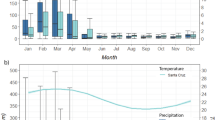Abstract
The Arctic sea ice is a powerful image of Earth’s polar regions. Krupnik et al. (2010) write that frozen saltwater that hardens on the surface of the sea is a crucial component of the global system and life in the polar regions. The description of its nature by scientists and indigenous observers brings this vision of the ice even closer to the heart: ‘it can be stiff and silent but also blasting and crushing with terrible noise, and can advance and retreat as a living being’ (ibid., p. 2). Today, Arctic sea ice is not only a significant element in scientific discourse and local knowledge, but a key constituent of global climatic and social change.
Access this chapter
Tax calculation will be finalised at checkout
Purchases are for personal use only
Preview
Unable to display preview. Download preview PDF.
Similar content being viewed by others
References
ACIA (2004) Impacts of a Warming Arctic: Arctic Climate Impact Assessment (Cambridge: Cambridge University Press).
AMAP (2002) Arctic Pollution Issues 2002 (Oslo: Arctic Monitoring and Assessment Programme).
Anderegg W. R. L., J. W. Prall, J. Harold and S. H. Schneider (2010) ‘Expert Credibility in Climate Change: Proceedings of the National Academy of Sciences, USA’, 107, 12107–09.
Appadurai, A. (1996) Modernity at Large: Cultural Dimensions of Globalization (Minneapolis and London: University of Minnesota Press).
Balibar, E., and I. Wallerstein (1991) Race, Nation, Class (London: Verso).
Barber, B. (1996) Jihad vs McWorld: How Globalism and Tribalism are Reshaping the World (New York: Ballantine).
Barry, J. (2007) Environment and Social Theory (London: Routledge).
Beck, U. (1992) Risk Society: Towards a New Modernity (London: Sage).
Beck, U. and J. Willms (2004) Conversations with Ulrich Beck (Cambridge: Polity Press).
Beck, U. (2010) ‘Climate for Change, or How to Create a Green Modernity?’ Theory, Culture & Society, (March/May), 27:2–3, 254–266.
Biermann, F. et al. (2012) ‘Navigating the Anthropocene: Improving Earth System Governance’, Science, 335:6074 (16 March), 1306–7.
Boykoff, M. T. and J. M. Boykoff (2004) ‘Balance as Bias: Global Warming and the US Prestige Press’, Global Environmental Change, 14, 125–36.
Boykoff, M. T. and J. T. Roberts (2007) Media Coverage of Climate Change: Current Trends, Strengths, Weaknesses (Oxford: UNDP).
Boykoff, M. T. and M. Mansfield (2010) Media Coverage of Climate Change/Global Warming. Center for Science and Technology Policy Research, University of Colorado and University of Exeter, Oxford University. Online: http://science-policy.colorado.edu/media_coverage/.
Christensen, M. (2011) ‘Discursively Shaping the Environment: Swedish National and Regional Media Coverage of The United Nations Climate Change Conference in Copenhagen (“COP15”)’. Paper presented to the Global Communication and Social Change Division of the International Communication Association (ICA) Conference, May 2011, Boston.
Crutzen, P. J. (2002) ‘Geology of Mankind’, Nature, 415:23.
Fukuyama, F. (1992) The End of History and the Last Man (New York: Free Press).
Giddens, A. (1990) The Consequences of Modernity (Cambridge: Polity).
Hansen, A. (2011) ‘Communication, Media and Environment: Towards Connecting Research on the Production, Content and Social Implications of Environmental Communication’, International Communication Gazette, 43:1–2, 7–26.
Huebert, R., H. Exner-Pirot, A. Lajeunesse and J. Culledge (2012) Climate Change & International Security: The Arctic as a Bellwether. Online:http://www.c2es.org/publications/climate-change-international-arctic-security.
IPCC (2007a) Climate Change 2007: Climate Change Impacts, Adaptation and Vulnerability. Summary for Policymakers. Working Group II Contribution to the Intergovernmental Panel on Climate Change Fourth Assessment Report (Geneva: Intergovernmental Panel on Climate Change).
— (2007b) Climate Change 2007: The Physical Science Basis. Summary for Policymakers. Contribution of Working Group I to the Fourth Assessment Report of the Intergovernmental Panel on Climate Change (Geneva: Intergovernmental Panel on Climate Change). Online: www.ipcc.ch/pdf/assessment-report/ar4/wg1/ar4-wg1-spm.pdf.
Krupnik, I., C. Aporta, S. Gearheard, G.J. Laidler, and L. Kielsen Holm (eds.) (2010) SIKU: Knowing Our Ice Documenting Inuit Sea Ice Knowledge and Use. Dordrecht: Springer.
Leiserowitz, A. et al. (2010) ‘Climategate, Public Opinion, and the Loss of Trust’ (July 2). Online at SSRN: http://ssrn.com/abstract=1633932 or http://dx.doi.org/10.2139/ssrn.1633932.
Lenton, T. M. et al. (2008) ‘Tipping Elements in the Earth’s Climate System’, Proceedings of the National Academy of Sciences, 105:6 (February 12), 1786–93. doi:10.1073/pnas.0705414105.
David Lowenthal (2012) ‘The Quest for the Unity of Knowledge’, The Stockholm Archipelago Lectures, KTH Environmental Humanities Laboratory, 19 September.
Marquart-Pyatt, S. T., et al. (2011) ‘Understanding Public Opinion on Climate Change: A Call for Research’, Environment: Science and Policy for Sustainable Development, 53:4, 38–42.
Morley, D., and K. Robins (1995) Spaces of Identity (London: Routledge)
Nilsson, A. E. (2007) ‘A Changing Arctic Climate: Science and Policy in the Arctic Climate Impact Assessment’ (Linköping, Sweden: Department of Water and Environmental Studies, Linköping University).
— (2012) The Arctic Environment from Low to High Politics. Arctic Yearbook 2012. Northern Research Forum and University of the Arctic. Online: http://www.arcticyearbook.com/.
Østreng, W. (2009) (ed.) Transference. Interdisciplinary Communications 2008/2009 (Oslo: CAS).
Rockström, J., et al. (2009) ‘Planetary Boundaries: Exploring the Safe Operating Space for Humanity’, Ecology and Society, 14:2, 32. Online: http://www.ecology-andsociety.org/vol14/iss2/art32/.
Sassen, S. (2008) Territory, Authority and Rights: From Medieval to Global Assemblages (Princeton: Princeton University Press).
Silverstone, R. (1994) Television and Everyday Life (London: Routledge)
— (2006) Media and Morality: On the Rise of the Mediapolis (London: Polity).
Wang, M., and J. E. Overland (2012) ‘A Sea Ice Free Summer Arctic Within 30 Years: An Update from CMIP5 Models’, Geophysical Research Letters, 39:18 (September 25). doi:10.1029/2012GL052868. Online: http://www.agu.org/pubs/crossref/pip/2012GL052868.shtml.
Wassmann, P., and T. M. Lenton (2012) ‘Arctic Tipping Points in an Earth System Perspective’, AMBIO, 41:1 (February 1), 1–9. doi:10.1007/s13280-011-0230-9.
Editor information
Editors and Affiliations
Copyright information
© 2013 Miyase Christensen, Annika E. Nilsson and Nina Wormbs
About this chapter
Cite this chapter
Christensen, M., Nilsson, A.E., Wormbs, N. (2013). Changing Arctic — Changing World. In: Christensen, M., Nilsson, A.E., Wormbs, N. (eds) Media and the Politics of Arctic Climate Change. Palgrave Macmillan, London. https://doi.org/10.1057/9781137266231_8
Download citation
DOI: https://doi.org/10.1057/9781137266231_8
Publisher Name: Palgrave Macmillan, London
Print ISBN: 978-1-349-44315-4
Online ISBN: 978-1-137-26623-1
eBook Packages: Palgrave Media & Culture CollectionLiterature, Cultural and Media Studies (R0)




